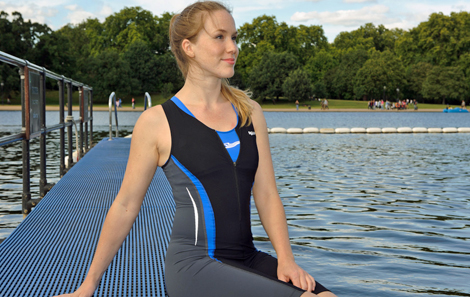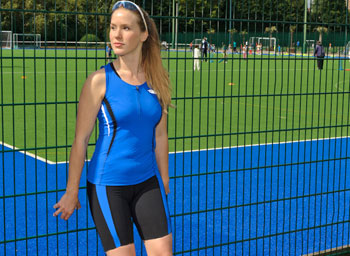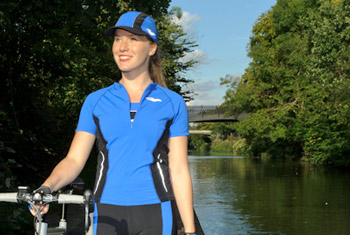Starting out and wondering what to wear in triathlon training and racing?
When it comes to competing in triathlon, the last thing you need to worry about is what to wear, right? Wrong! Choosing your triathlon clothing and packing your triathlon transition bag can be a challenging part of the sport- and one that very few train for! There’s nothing worse than training towards a big race, only to find that your kit doesn’t perform on the day or that you’ve forgotten to pack your cycling shoes.

To help you figure out what you need and why you need it, Trigirl is offering up our list of race day needs, hints and recommendations. Plus check out our handy printable race day checklist for all of the bits and pieces that you mustn’t forget when you head out early on the big day!
The first basic rule is: stay away from cotton. Cotton holds moisture and moisture causes everything from a saggy outfit to blisters and chafing. All of Trigirl’s kit is made from high-quality, wicking fabrics that will dry quickly and resist bacteria.
The beauty of triathlon-specific kit (a ‘trisuit’) is that it involves one outfit that is designed to function across all triathlon disciplines (there’s no time or place in a race to change!)
So, should you choose a one-piece or a two-piece trisuit?
A one-piece trisuit is a streamlined, sleek option. It will easily go from swim to bike to run with no worry that the top might ride up and is often the option chosen by the pros for aerodynamic benefits. Trigirl’s one-piece kit is designed to flatter, so even though it’s tight-fitting, you’ll feel comfortable and confident. Might we suggest the beautiful Trigirl Tri Tropical trisuit?
 A two-piece kit can be more versatile. It makes it easy to mix your favourite top with your favourite shorts. A two-piece is therefore a great choice if you are a different size on top and bottom and it is perfect for racing and training.
A two-piece kit can be more versatile. It makes it easy to mix your favourite top with your favourite shorts. A two-piece is therefore a great choice if you are a different size on top and bottom and it is perfect for racing and training.
Not to mention, two-pieces are a bit easier when a long race or race day nerves lead to frequent toilet stops! Trigirl’s two-piece kit is designed to be worry-free as well. The top stays where it is supposed to, the shorts are higher in the back waistband (never too low while cycling!). They have soft gripper tape in the legs so they don’t ride up.
And while we’re on the subject (sort of)- tri shorts are made with a comfortable built-in quick drying pads, so no knickers are required. Check out Trigirl’s two-piece sets for tops and shorts that are made for each other!
Triathlon Kit for the Swim
For the swim, you’ll need a swim hat. Most races provide these in colours that coordinate, no, not with your trisuit, but rather with your start wave. It’s always a good idea to pack an extra, just in case. You may even want to wear it under the cap provided for warmth in the case of very cold water.
And speaking of cold water, if you’re swimming in open water in the UK, the water is typically cold enough to make a wetsuit desirable (and if the water is under 14 degrees C, British Triathlon rules require one). The bad news is that wetsuits can be expensive; not ideal if you’re just starting out and have a lot of other triathlon clothing and equipment to purchase. The good news is that there are many wetsuit hire companies which allow you to hire a suit at a reasonable price. They may even apply the hire fee to the cost of purchase if you choose to buy the suit later.
Make sure that you get the wetsuit in time to try it at least once. Wetsuits take some getting used to and fit is paramount!
Triathlon Kit for the Bike and Run
For cycling, a helmet is not only a potential life-saver, it’s a piece of your kit that’s required by triathlon rules in every race. Choosing a comfortable helmet is key. Cycling is the longest stage of triathlon and since you’ll be using it to race and train, you’ll spend a lot of time sporting it. Try on different helmets and see what fits and feels comfortable for you. The main difference in expensive helmets and less expensive models is weight, not safety features. If you find a very comfy helmet at a low price point, it’s not necessary to spend a lot.
 For the run leg, head gear is optional, but a billed cap is a good idea. For something so unassuming, a running cap does a lot to protect you from the elements, whether the day brings bright sun or heavy rain. Choose one that is breathable and comfortable.
For the run leg, head gear is optional, but a billed cap is a good idea. For something so unassuming, a running cap does a lot to protect you from the elements, whether the day brings bright sun or heavy rain. Choose one that is breathable and comfortable.
Another important consideration is keeping your feet dry and comfortable. Not every triathlete wears socks (especially sprint-distance speedsters, trying to save precious seconds on their transition times). However, if you are prone to blisters or you’re going long, breathable, wicking socks are a must. Once again, absolutely NO cotton. There is a wide range of fibre contents and thicknesses on the market. Try out different socks in training to determine what’s best for you before a race.
One last (important!) suggestion- nothing new on race day. Plan your race day wardrobe in the same way that you’d plan what you’re wearing for other big days in your life.
Test out your kit in training so that you know you’re comfortable, confident and ready to race… all the way to the finish line!
You might also want to check out our article on One-Piece vs Two-Piece trisuits.
